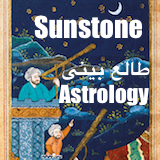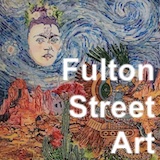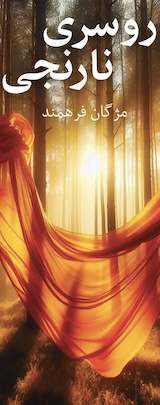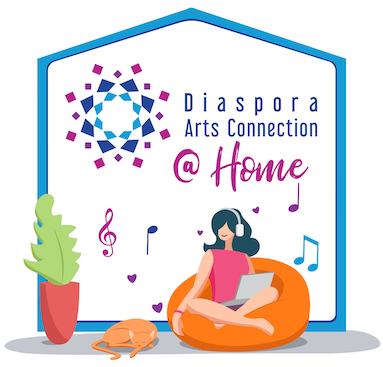Rojin Shafiei's Nuit Blanche exhibit. (Azad Amin)
Nickie Shobeiry
CBC
On September 16 in Tehran, a 22-year old woman, Mahsa Amini — also known by her Kurdish name Jina Amini — died after being taken into police custody for violating Iranian morality laws. She was accused of wearing her hijab "improperly."
According to eyewitness accounts, Amini was severely beaten by police officers. Her death sparked a series of record-breaking protests in Iran that are still ongoing nearly two months later.
For the Toronto-based Iranian-Canadian artist and filmmaker Hajar Moradi, news of Amini's death and the protests came to her quickly through Farsi-language Twitter. Moved to action, Moradi helped arrange a demonstration at Queen's Park just three days after Amini's death, in solidarity with the Iranian protestors. Moradi was inspired by three videos of Iranian women cutting their hair circulating on social media.
"So many people joined us [in Queen's Park]," Moradi says — estimating a total of around 150 people. "Some people joined us in cutting their hair. It was a very emotional moment; everyone around us started crying."
In her art, which includes everything from painting to sculpture to animation, Moradi explores questions of identity, resilience, feminism and gender. For the Queen's Park protest, she designed a poster using the protest slogan "Say Her Name" — a call-and-response chant answered with "Mahsa Amnini" — inviting the community to join her and her friends in cutting their hair in protest against Iran's government and its mandatory hijab laws.
"Artists try to visualize people's demand and turn it into a medium that's relatable to everyone," she says.
For decades, Iranians — especially women, ethnic minorities and the queer community — have had their human rights seriously curtailed under the Iranian government's strict Islamist regime. While there have been cycles of political resistance movements throughout Iran's recent history, the current one is widely considered to be one of the most significant protests in Iran since the founding of the Islamic Republic in 1979 — women-led or otherwise — with thousands pouring into the streets in provinces across Iran, including schoolchildren.
The diaspora has shown up in solidarity; in Berlin, 80,000 Iranians and supporters marched the streets — the largest gathering in history of Iranians against the Islamic Republic of Iran. For many Iranian diaspora artists, showing solidarity through their art is one of the most meaningful ways to feel connected to the protest movement. As an award-winning multidisciplinary artist, Moradi feels obligated to use her work as a voice in the face of injustice. Since Iran's Green Movement protests in 2009, demanding the removal of a former president following a rigged election, Moradi has been politically active through her art.
"I am an artist and my weapon is my art," she says. "I think art offers powerful opportunities to express our common humanity; [it] carries the social and political demands of its own people. If done right, it can change society."
Art that tells the stories of women arrested by the regime
Before the Mahsa Amini protests started, Toronto and Montreal-based Iranian artist and filmmaker Rojin Shafiei was gearing up for Toronto's Nuit Blanche, a city-wide arts exhibit. Just two weeks before the exhibit's October 1st launch date, Mahsa Amini's death hit the headlines and protests swept across Iran.
"I told my curator, I cannot stand beside a piece and talk about something that is not about the recent protests in Iran — I feel horrible," Shafiei says. She adds that this was a personal choice, and not a judgment on any artist who might have chosen differently to her.
Shafiei put together a new audio-visual exhibit, gathering cell-phone footage from protests in Iran sent to her by her friends. "I got a story from a trans woman, a disabled woman, a university student, a mother," she says. "All those stories are about people who have been arrested so far."
Along with clips from the news, Shafiei wove those videos between footage of herself cutting her hair. "With every single hair that I cut, I brought the name of one of the people that was killed during the protests in Iran."
It was an intense process: Shafiei was working on the exhibit mere hours before her showing. "All I wanted to show through that work was 1 per cent of the challenges that people, especially woman and queer people, are going through in Iran," she says.
On October 1st, the date of Nuit Blanche, 50,000 people attended a solidarity in Richmond Hill near Toronto. Rallies took place in 150 cities around the world, and in Iran, university students took their protests to the streets, in the face of violent clashes with authorities.
Art that amplifies the voices of Iranians, for Iranians
For Golshan Abdmoulaie — an Iranian, Toronto-based writer, poet, photographer and filmmaker — the most important thing right now is amplifying the voices of Iranian people in Iran, as well as emphasizing the fact that the experience of Islam is completely different in Iran than outside.
"An Iranian person living in Canada or in the U.S. is going to experience being the 'other' as a Muslim subject, whereas in Iran, they don't have that same otherness — the Islamic clergy is the ruling class," Abdmoulaie says. In summary: supporting the fall of Iran's regime does not make you Islamophobic.
She shares a photograph that she took of her grandmother during her last trip to Iran; her grandmother is sitting on a stool, having her hair dyed. "It's important for me to make art about Iran that's outside of the Western or white gaze — outside of what they expect Iran to look like," Abdmoulaie says.
"She hated the regime so much," Abdmoulaie says of her grandmother. "When she was younger, she would write with lipliner on the streets, 'death to the Islamic regime.' She's definitely my idol, and someone that I think would be really, really, really happy to see [the protests] going on right now, in particular schoolgirls [taking part]."
Most recently, Abdmoulaie co-wrote the film This Place alongside Kawennáhere Devery Jacobs: a queer love story about two young women, one Iranian and Kanienʼkehá:ka, the other Tamil. Directed by V.T. Nayani, the film was recently screened at TIFF >>>










Comments